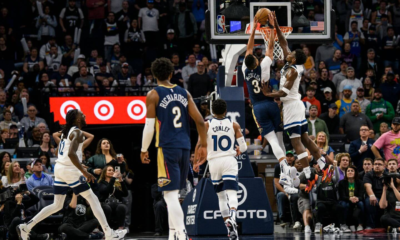Sports
'Hoop Muses' author Kate Fagan speaks on state of women's … – USA TODAY
Maya Moore is one of the biggest names in basketball. But what would happen if, in the year 2072, players didn’t know who the four-time WNBA champion was?
That is a question Kate Fagan ponders in her latest book, “Hoop Muses,” an illustrated timeline of the “her-story” of women’s basketball that combines a fictional glimpse into the future of the 75th anniversary of the WNBA with an in-depth look at the people and events that built the game into what it is today. The award-winning journalist seeks to pay homage to the names not yet given proper credit in hopes that basketball fans will remember and celebrate them.
“Hoop Muses” is far from a dusty textbook. Fagan enlisted four-time WNBA champion and 2011 Finals MVP Seimone Augustus to curate the book and New York-based artist Sophia Chang to illustrate it. The bright turquoise cover with portraits of Tennessee’s Pat Summitt, USC’s Cheryl Miller, UConn’s Diana Taurasi and the iconic Air Swoopes sneakers is alluring.
WOMEN’S HISTORY MONTH:Brittney Griner, NFL coaches and more ways women have made history in sports
“I was just thinking about the history of the game and then also a way to tell it that might be a little sexier than you would traditionally think,” Fagan, who played college basketball with the Colorado Buffaloes and professionally overseas, told USA TODAY Sports. “I’m not sure you’d get much traction in just saying, ‘I’m going to talk about the 1930s high school women’s game.’ But if you bring an illustrator like Sophia Chang in to show visually and make the colors pop and bring in a very modern spin, then all of a sudden, you’re freed up to tell some different stories that might not necessarily be what people want to dig into if you didn’t have that kind of flair and pop and style to it.
“And then also bringing in Simone Augustus who’s a legend in the women’s game to help curate and pick and bounce things off of. She’s got Olympic gold medals and WNBA titles, so it was kind of like a dream team.”
Fagan chronicles the women’s game from the very beginning, 130 years ago, Senda Berenson, who was in charge of the physical education program at Smith College in Massachusetts, found a pamphlet of James Naismith’s “Physical Education” detailing the rules of his new game, basket ball. She held the first scrimmage for her girls March 22, 1893. After asking the students how they felt about the game, one said she felt more “endurance, lung capacity, alertness, courage, and toughness.”
The game has held value for players from the start, but it has been an uphill battle to have the women’s game legitimized. Building blocks for the modern game included the Women’s Professional Basketball League being founded in 1978; Ann Meyers becoming the first and only woman to sign and NBA contract in 1979; Team USA winning its first gold medal at the 1984 Summer Olympics; and UConn’s success in the 1990s. The WNBA celebrated its 25th anniversary in 2022 and this year’s NCAA women’s tournament is being aired in prime time just like the men’s games — and drawing record viewership.
But there is still room for growth.
Fagan cited the COVID-19 pandemic when the 2021 NCAA tournaments were played in bubble conditions as a “rock bottom moment” that showed the disparity in resources between the men’s and women’s game. The women’s teams were given less appetizing food, fewer personal care items and the NCAA upgraded their training facility after images of a pile of the yoga mats and set of dumbells that initially made up the “weight room” went viral. She also noted the ongoing fight for WNBA teams to get charter flights as a point of contention.
Despite that, she is positive about the state of women’s basketball with stars like Breanna Stewart advocating for the future of the game by signing with the New York Liberty, and college players Caitlin Clark, Paige Bueckers and Aliyah Boston becoming household names.
RISING STAR:‘Absolutely incredible’ Caitlin Clark is perfect player at perfect time for women’s basketball
“I feel like finally there’s a corner that has been turned,” she said. “There’s just an ownership that women both at the college level and in the WNBA level have taken in terms of demanding more, taking ownership over their games and their collective bargaining agreements. A lot of that is just rooted in a firm belief now that the foundation of the women’s game is solid. It’s not going anywhere.”
Upon the release of “Hoop Muses,” Fagan took to Twitter to share more about her vision for the book. She said she wanted to elevate the women’s game into the same level of lore that the men’s game has achieved.
“What became clear to me in writing HOOP MUSES was the consistent erosion of women’s sports history,” she said. “That is, after it’s happened, we rarely make movies of it, or documentaries, we didn’t sell posters and limited edition photographs of key moments. Nostalgia — that’s a byproduct of history. So, to borrow a line from Jay-Z, women’s sports is always trying to re-introduce itself. The good news, for us lovers of women’s sports, is that the history is ACTUALLY rich with dynamic, untold stories. Everywhere, in every city and town, across every decade, there were women playing the game they loved. And there was scandal and intrigue and drama — seriously, the kind of stories that could make scripted shows — and all of it was intertwined with, and reflected, our country’s own history.”
The book was written over a period of two years and, after winning an Emmy Award and being a New York Times best-seller, “Hoop Muses” has a special place in Fagan’s heart.
“This book is the book that I feel like is a meshing of everything I love unlike anything else I’ve ever done. It was the hardest book I ever made,” she said. “I thought, ‘Oh, it’s an illustrated book. It’ll be easier somehow. But there’s so many moving parts and so much to pay attention to in the production process. So it’s my favorite book I’ve ever done to this point.”








